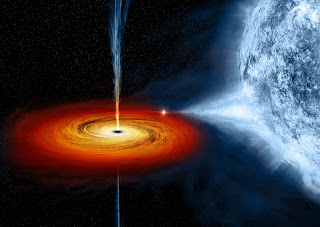Cygnus X-1
Cygnus X-1 (abbreviated Cyg X-1) is a well-known galactic X-ray source. It is thought to be a black hole in the constellation Cygnus.
It was discovered in 1964 during a rocket flight, and is one of the strongest X-ray sources seen from Earth. Cygnus X-1 was the first X-ray source accepted as a black hole. It is among the most studied astronomical objects in its class. The compact object is estimated to have a mass about 14.8 times the mass of the Sun. It is too small to be any known kind of normal star, or other likely object besides a black hole. If so, the radius of its event horizon is about 44 km.
The location of Cygnus X-1 (circled) to the left of Eta Cygni in the constellation Cygnus based on known coordinates
Cygnus X-1 belongs to a high-mass X-ray binary system, located about 6,070 light-years from the Sun, that includes a blue supergiant variable star designated HDE 226868 which it orbits at about 0.2 AU, or 20% of the distance from Earth to the Sun. A stellar wind from the star provides material for an accretion disk around the X-ray source. Matter in the inner disk is heated to millions of degrees, generating the observed X-rays. A pair of jets, arranged perpendicularly to the disk, are carrying part of the energy of the infalling material away into interstellar space.
This system may belong to a stellar association called Cygnus OB3, which would mean that Cygnus X-1 is about five million years old and formed from a progenitor star that had more than 40 solar masses. The majority of the star's mass was shed, most likely as a stellar wind. If this star had then exploded as a supernova, the resulting force would most likely have ejected the remnant from the system. Hence the star may have instead collapsed directly into a black hole.[11]
Cygnus X-1 was the subject of a friendly scientific wager between physicists Stephen Hawking and Kip Thorne in 1975, with Hawking betting that it was not a black hole. He conceded the bet in 1990 after observational data had strengthened the case that there was indeed a black hole in the system. This hypothesis lacks direct empirical evidence but has generally been accepted from indirect evidence.
Source : https://en.m.wikipedia.org/wiki/Cygnus_X-1


